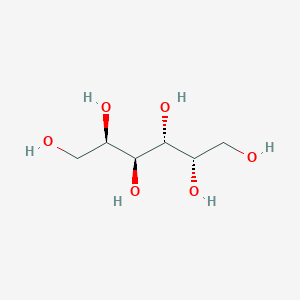| General Information of MET (ID: META00161) |
| Name |
Galactitol
|
| Synonyms |
Click to Show/Hide Synonyms of This Metabolite
(2R,3S,4R,5S)-Hexane-1,2,3,4,5,6-hexol; Ambap5938; D-Dulcitol; D-Galactitol; Dulcite; Dulcitol; Dulcose; Euonymit; Hexitol; L-Galactitol; Melampyrin; Melampyrit; Melampyrite; Melampyrum; Meso-galactitol
|
| Source |
Endogenous;Escherichia Coli Metabolite;Food;Toxins/Pollutant;Microbial
|
| Structure Type |
Carbohydrates and carbohydrate conjugates (Click to Show/Hide the Complete Structure Type Hierarchy)
Organic oxygen compounds
Organooxygen compounds
Carbohydrates and carbohydrate conjugates
|
| PubChem CID |
|
| HMDB ID |
|
| Formula |
C6H14O6
|
| Structure |
<iframe style="width: 300px; height: 300px;" frameborder="0" src="https://embed.molview.org/v1/?mode=balls&cid=11850"></iframe>
|
 |
|
3D MOL
|
2D MOL
|
|
Click to Show/Hide the Molecular/Functional Data (External Links/Property/Function) of This Metabolite
|
| KEGG ID |
|
| ChEBI ID |
|
| FooDB ID |
|
| ChemSpider ID |
|
| METLIN ID |
|
| Physicochemical Properties |
Molecular Weight |
182.17 |
Topological Polar Surface Area |
121 |
| XlogP |
-3.1 |
Complexity |
105 |
| Heavy Atom Count |
12 |
Rotatable Bond Count |
5 |
| Hydrogen Bond Donor Count |
6 |
Hydrogen Bond Acceptor Count |
6 |
| Function |
Galactitol or dulcitol is a sugar alcohol that is a metabolic breakdown product of galactose. Galactose is derived from lactose in food (such as dairy products). When lactose is broken down by the enzyme lactase it produces glucose and galactose. Galactitol has a slightly sweet taste. It is produced from galactose in a reaction catalyzed by aldose reductase. When present in sufficiently high levels, galactitol can act as a metabotoxin, a neurotoxin, and a hepatotoxin. A neurotoxin is a compound that disrupts or attacks neural cells and neural tissue. A hepatotoxin as a compound that disrupts or attacks liver tissue or liver cells. A metabotoxin is an endogenously produced metabolite that causes adverse health effects at chronically high levels. Chronically high levels of galactitol are associated with at least two inborn errors of metabolism, including galactosemia and galactosemia type II. Galactosemia is a rare genetic metabolic disorder that affects an individual's ability to metabolize the sugar galactose properly. Excess lactose consumption in individuals with galactose intolerance or galactosemia activates aldose reductase to produce galactitol, thus depleting NADPH and leading to lowered glutathione reductase activity. As a result, hydrogen peroxide or other free radicals accumulate causing serious oxidative damage to various cells and tissues. In individuals with galactosemia, the enzymes needed for the further metabolism of galactose (galactose-1-phosphate uridyltransferase) are severely diminished or missing entirely, leading to toxic levels of galactose 1-phosphate, galactitol, and galactonate. High levels of galactitol in infants are specifically associated with hepatomegaly (an enlarged liver), cirrhosis, renal failure, cataracts, vomiting, seizure, hypoglycemia, lethargy, brain damage, and ovarian failure.
|
|
Regulatory Network
|
|
|
|
|
|
|
|
|
 click to show the details of this protein
click to show the details of this protein
 click to show the details of experiment for validating this pair
click to show the details of experiment for validating this pair

